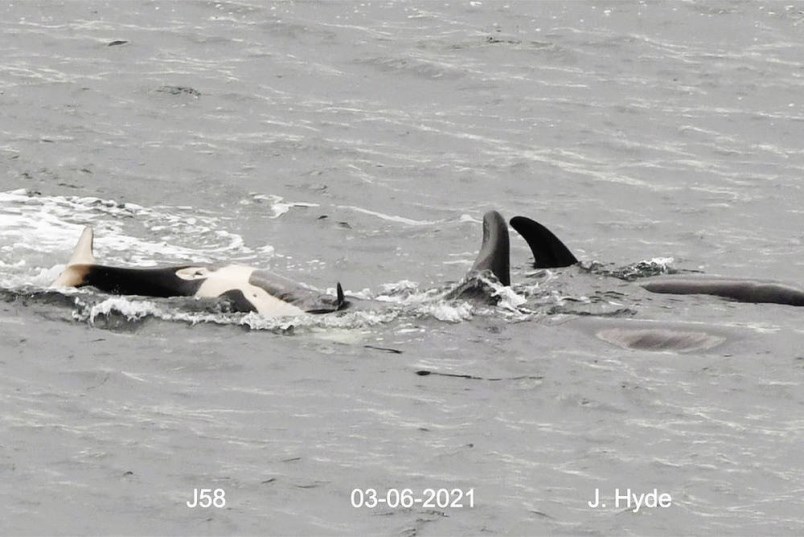Three new orca calves born over the past six months — and five since 2019 — provide a glimmer of hope for the future of southern resident killer whales.
And when one revealed itself as a female this week, it inspired even more optimism for the fledgling pods, say researchers.
“Every female is a future matriarch, a mother of potentially five, six or seven babies over their lifetime,” said Kelley Balcomb-Bartok of the Center for Whale Research in Friday Harbour, Washington, which tracks the endangered resident orcas.
“Males are, of course, welcome and valued, too, but every girl born is precious to [the southern residents’] existence. Even after their reproductive days are over, they play major roles.”
On Sunday — on the eve of International Women’s Day — researchers confirmed that J58, born last September, was indeed a female, to the delight of the whale-watching community.
Photographer Jeanne Hyde had captured the baby whale on the west side of San Juan Island on Saturday playing with her mother, J58, as she was rolling and showing her underside.
J58 hasn’t been nicknamed as yet. She was born Sept. 24 — the second calf welcomed to J Pod after J57 was born Sept. 4 and later confirmed as a male. He was the first calf born to the pod in more than two years.
Now everybody is awaiting the gender reveal on the latest birth.
Last month, the Center for Whale Research confirmed that a new calf has been born into L-Pod — the first for the pod since 2019.
L125 was spotted during a rare convergence of J, K, and L pods in Haro Strait.
Researcher Dave Ellifrit captured images showing L125’s fetal folds, indicating a relatively recent birth. “It is nicely filled out and appears to be a perfectly normal little calf,” he said.
Researchers said L125’s size and shape were typical of a calf in good physical condition. The calf is a fourth offspring for L86, who has given birth to two other calves now deceased, including L112, who was killed by blunt force trauma during military exercises in 2012.
The birth of the latest orca brings the southern resident population to 75, said Balcomb-Bartock.
He said legions of “orca-teers” who watch for and photograph the resident pods are likely to have a gender photo soon on the latest calf.
Gavin Hanke, curator for vertebrate zoology at the Royal British Columbia Museum, said females are critical to orca pods beyond the obvious reproductive potential.
“Females are the leaders, matriarchs … they teach the pod’s dialect and essentially are the knowledge keepers,” said Hanke.
Researchers says female orcas generally live longer, ranging from 40 to 80 years, and can have several calves over their breeding life, up to age 60.
Even beyond those breeding years, female orcas serve a valuable role in their family pods, said Balcomb-Bartock. “In their post-productive roles, they become grandmothers very similar to humans, in that they participate in the raising of the young, help to find food and provide general knowledge.”
The oldest resident orca on record was J2, who was estimated to be well over 100 when she died in 2016, according to the Center for Whale Research.
Her son J1 was considered the longest-living resident male. He died in 2010 at an estimated age of 60.
Each of the three pods of southern resident killer whales is led by older females, according to data from the Orca Network.
L-Pod, the largest group with 34, is led by L22, born in 1971, and L-25, born in 1928. J-Pod, with 24 members, is led by J16, born in 1972. K-Pod has 17 members and is led by K12, also born in 1972.
Two resident killer whales remain in captivity.
Corky, a northern resident male orca captured in 1969, is 56 and in SeaWorld San Diego.
Tokitae, also known as Lolita, is the only southern resident killer whale left in captivity. She’s 57 and at Miami Seaquarium.
Tokitae was part of a mass roundup of orcas on Aug. 8, 1970, when about 100 orcas were herded into Penn Cove off Whidbey Island, Washington, 50 kilometres southeast of Victoria. Seven were captured in nets and taken to marine parks around the world. All were dead by 1987, except for Tokitae, who is still performing shows.
Legal efforts to bring Tokitae home to the Salish Sea continue.
Read more from the Times Colonist




